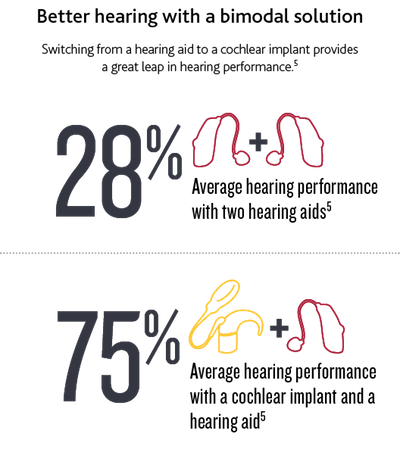Hearing with both ears
To improve your hearing performance and help you understand conversations more clearly, you might need to consider a solution that helps you hear your best with both ears.

What you'll find on this page
- Discover the importance of hearing with both ears
- Learn the benefits of bimodal hearing (a hearing implant in one ear and a hearing implant in the other ear)
- Learn when to consider bilateral (two) hearing implants
The importance of hearing with both ears
Ears work as a team, and the brain needs them both to best understand speech and tell where sounds are coming from.1
Binaural hearing
It is only when you hear with two ears that your brain is able to fully understand sound. If you can only hear in one ear (unilateral hearing) it may be difficult to:
- Avoid the head shadow effect - Sounds that come from your ‘bad side’ fall in the shadow of your head. They have to then travel around your head so your ‘good ear’ can send them to the brain. As a result, they may be more difficult to hear and understand clearly, especially in noise.2 This is especially true for higher-frequency sounds.2
- Understand speech in noise - Consonants are higher-frequency sounds that contain much of the meaning of speech. Because of the head shadow effect, it can be difficult for people with only one good ear to understand speech in noisy situations.2
- Locate sound - Not being able to properly tell where sound is coming from can cause problems. For children, it may be hard to understand the teacher in class. For adults, driving through traffic can be difficult. For both, crossing a busy road could even be dangerous.
Binaural hearing and speech development in children
Being able to hear with both ears helps build speech and language understanding. This is important for children’s learning and development.3
“Binaural hearing provides you with the ability to tell where sounds are coming from and to understand speech in noisy environments. It allows you to take advantage of brain mechanisms that can separate the speech you want to hear from other sounds in the area.”
- Ruth Litovsky, Ph.D., Profession of Communication Disorders,
University of Wisconsin, Director, Binaural Hearing Lab, Waisman Center
Bimodal hearing (hearing aid and hearing implant)
Bimodal hearing combines the benefits of a hearing aid in one ear and a hearing implant in the other ear. The result is a richer and more natural hearing experience.3
With a bimodal hearing solution, you may experience many benefits, including:
- Clearer sound and improved speech understanding, especially in noise4-6
- Being able to better tell where sounds are coming from6
- Being able to enjoy music more.7,8
Cochlear’s range of cochlear implant and bone conduction implant systems work with any hearing aid to provide the benefits of bimodal hearing.

Bilateral implants
If you have a bimodal solution but still struggle to understand speech, bilateral hearing implants may be the answer to help you communicate effectively. A hearing health professional who specializes in all types of hearing solutions will be able to assist you.
“Now I’m bilateral, and that is just like a whole other world opening up. It’s like going from black and white to color, high-definition TV.”
- Deb A. - Nucleus® recipient

Disclaimer
Please seek advice from your medical practitioner or health professional about treatments for hearing loss. They will be able to advise on a suitable solution for the hearing loss condition. All products should be used only as directed by your medical practitioner or health professional. Not all products are available in all countries. Please contact your local Cochlear representative.
Views expressed by Cochlear recipients and hearing health providers are those of the individual. Consult your hearing health provider to determine if you are a candidate for cochlear technology and to understand the associated risks and benefits. Individual results may vary.
ACE, Advance Off-Stylet, AOS, AutoNRT, Autosensitivity, Beam, Button, CareYourWay, Carina, Cochlear, 科利耳, コクレア, Cochlear SoftWear, Codacs, ConnectYourWay, Contour, Contour Advance, Custom Sound, ESPrit, Freedom, Hear now. And always, HearYourWay, Hugfit, Hybrid, Invisible Hearing, Kanso, MET, MicroDrive, MP3000, myCochlear, mySmartSound, NRT, Nucleus, Off-Stylet, Slimline, SmartSound, Softip, SPrint, True Wireless, the elliptical logo, WearYourWay and Whisper are either trademarks or registered trademarks of Cochlear Limited. Ardium, Baha, Baha SoftWear, BCDrive, DermaLock, EveryWear, Vistafix, and WindShield are either trademarks or registered trademarks of Cochlear Bone Anchored Solutions AB.
References
- Litovsky RY, Johnstone PM, Godar SP. Benefits of bilateral cochlear implants and/or hearing aids in children. Int J Audiol. 2006; 45(Suppl): S78-91.
- Weaver, J. "Single-Sided Deafness: Causes, and Solutions, Take Many Forms." Hearing Journal 68.3 (2015): 20-24. Web. 28 Apr. 2017.
- Ching TY, Psarros C, Hill M, Dillon H, Incerti P. Should children who use cochlear implants wear hearing aids in the opposite ear?. Ear and hearing. 2001 Oct 1;22(5):365-80.
- Dorman MF, Gifford RH, Spahr AJ, McKarns SA. The benefits of combining acoustic and electric stimulation for the recognition of speech, voice and melodies. Audiology and Neurotology. 2008;13(2):105-12.
- Gifford RH, Dorman MF, McKarns SA, Spahr AJ. Combined electric and contralateral acoustic hearing: Word and sentence recognition with bimodal hearing. Journal of Speech, Language, and Hearing Research. 2007 Aug 1;50(4):835-43.
- Wolfe J, Morais M, Schafer Erin. Speech recognition of bimodal cochlear implant recipients using a wireless audio streaming accessory for the telephone. Otol Neurotol. 2016 Feb;37(2):e20-5.
- Potts LG, Skinner MW, Litovsky RA, Strube MJ, Kuk F. Recognition and localization of speech by adult cochlear implant recipients wearing a digital hearing aid in the nonimplanted ear (bimodal hearing). Journal of the American Academy of Audiology. 2009 Jun 1;20(6):353-73.
- Crew, J. D., Galvin, J. J., & Fu, Q. J. (2016). Perception of Sung Speech in Bimodal Cochlear Implant Users. Trends in Hearing, 20, 1–15. https://doi.org/10.1177/2331216516669329





